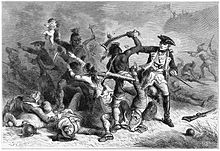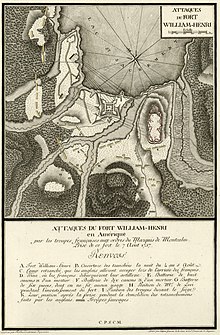Fort William Henry

The British Fort William Henry , named after Prince William Henry , a grandson of King George II , was located at the southern end of Lake George in what is now the US state of New York . During the 1754-1763 discharged French and Indian War ( French and Indian War ) was there as a base for attacks against the French Fort Carillon ( Fort Ticonderoga built) and was part of a chain of British and French fortifications along the major waterway from New York to Quebec .
history
In August 1757, a siege began on the fort defended by 2,200 British soldiers and American militiamen, including Rogers' Rangers , by a French army under the command of Louis-Joseph de Montcalm . The attackers numbered 8,000 men, including 3,000 line troops, 3,000 militiamen and about 2,000 Indians. The garrison, commanded by Lieutenant Colonel George Monro , had to capitulate after heavy fire from the French and the failure of an attempt at relief from the south.
The defenders and civilians who had previously fled to the fort withdrew after the surrender on generous terms. However, on the march, they were attacked by the French Indian allies. They did not agree to the surrender agreements because they saw themselves deprived of their spoils of war. Many of the withdrawing soldiers and civilians were killed, captured or robbed. For propaganda reasons, this incident was later exaggerated and would go down in history as the Fort William Henry massacre . Contemporary reports speak of up to 1,500 deaths, but the actual number is believed to have been between 70 and 180. The Indians even dug up and plundered the corpses of the occupation killed during the siege, thereby causing an epidemic. The French eventually burned the fort and withdrew to Ticonderoga.
A replica has been built on the former site of Fort William Henry in Lake George Parish and is a popular tourist attraction. The siege of the fort gained notoriety not least through the literary processing in James Fenimore Cooper's novel The Last of the Mohicans , which has been filmed several times.
literature
- The capture of Fort William Henry in North America by the Royal French Forces under the command of the Marquis of Montcalm in August 1757 ( digitized )
- Ian Steele: Betrayals. Fort William Henry and the “Massacre” , Oxford 1993.
- Paul Williams: Frontier Forts Under Fire: The Attacks on Fort William Henry (1757) and Fort Phil Kearny (1866). McFarland, Jefferson 2017, ISBN 978-1-4766-7093-5 .
Web links
- Fort William Henry Museum
- The Battle of Fort William Henry
- Plan of the attack on Fort William-Henri on August 7, 1757
- FORT WILLIAM HENRY ... The Siege & Massacre
Coordinates: 43 ° 25 ′ 13 ″ N , 73 ° 42 ′ 40 ″ W.

